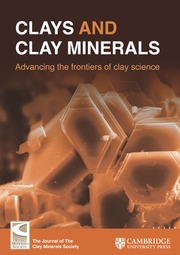Crossref Citations
This article has been cited by the following publications. This list is generated based on data provided by
Crossref.
Yu, Ching-Hsing
Newton, Susan Q.
Miller, David M.
Teppen, Brian J.
and
Schäfer, Lothar
2001.
Ab Initio Study of the Nonequivalence of Adsorption of D- and L-Peptides on Clay Mineral Surfaces.
Structural Chemistry,
Vol. 12,
Issue. 5,
p.
393.
López Arbeloa, F.
Chaudhuri, R.
Arbeloa López, T.
and
López Arbeloa, I.
2002.
Aggregation of Rhodamine 3B Adsorbed in Wyoming Montmorillonite Aqueous Suspensions.
Journal of Colloid and Interface Science,
Vol. 246,
Issue. 2,
p.
281.
Bujdák, Juraj
and
Iyi, Nobuo
2002.
Visible Spectroscopy of Cationic Dyes in Dispersions with Reduced-Charge Montmorillonites.
Clays and Clay Minerals,
Vol. 50,
Issue. 4,
p.
446.
Bujdák, J .
Iyi, N.
Kaneko, Y.
and
Sasai, R.
2003.
Molecular orientation of methylene blue cations adsorbed on clay surfaces.
Clay Minerals,
Vol. 38,
Issue. 4,
p.
561.
Yu, Ching-Hsing
Newton, Susan Q.
Norman, Mya A.
Schäfer, Lothar
and
Miller, David M.
2003.
Molecular Dynamics Simulations of Adsorption of Organic Compounds at the Clay Mineral/Aqueous Solution Interface.
Structural Chemistry,
Vol. 14,
Issue. 2,
p.
175.
Nakano, Masashi
Kawamura, Katsuyuki
and
Ichikawa, Yasuaki
2003.
Local structural information of Cs in smectite hydrates by means of an EXAFS study and molecular dynamics simulations.
Applied Clay Science,
Vol. 23,
Issue. 1-4,
p.
15.
Cygan, Randall T.
Guggenheim, Stephen
and
Koster van Groos, August F.
2004.
Molecular Models for the Intercalation of Methane Hydrate Complexes in Montmorillonite Clay.
The Journal of Physical Chemistry B,
Vol. 108,
Issue. 39,
p.
15141.
Tunega, Daniel
Haberhauer, Georg
Gerzabek, Martin H.
and
Lischka, Hans
2004.
SORPTION OF PHENOXYACETIC ACID HERBICIDES ON THE KAOLINITE MINERAL SURFACE – AN AB INITIO MOLECULAR DYNAMICS SIMULATION.
Soil Science,
Vol. 169,
Issue. 1,
p.
44.
Czı́merová, Adriana
Jankovič, Ľuboš
and
Bujdák, Juraj
2004.
Effect of the exchangeable cations on the spectral properties of methylene blue in clay dispersions.
Journal of Colloid and Interface Science,
Vol. 274,
Issue. 1,
p.
126.
Čapková, Pavla
Malý, Petr
Pospı́šil, Miroslav
Klika, Zdeněk
Weissmannová, Helena
and
Weiss, Zdeněk
2004.
Effect of surface and interlayer structure on the fluorescence of rhodamine B–montmorillonite: modeling and experiment.
Journal of Colloid and Interface Science,
Vol. 277,
Issue. 1,
p.
128.
Bujdák, Juraj
and
Iyi, Nobuo
2006.
Spectral and Structural Characteristics of Oxazine 4/Hexadecyltrimethylammonium Montmorillonite Films.
Chemistry of Materials,
Vol. 18,
Issue. 10,
p.
2618.
Sutton, Rebecca
and
Sposito, Garrison
2006.
Molecular simulation of humic substance–Ca-montmorillonite complexes.
Geochimica et Cosmochimica Acta,
Vol. 70,
Issue. 14,
p.
3566.
Bujdák, Juraj
2006.
Effect of the layer charge of clay minerals on optical properties of organic dyes. A review.
Applied Clay Science,
Vol. 34,
Issue. 1-4,
p.
58.
Teppen, Brian J.
and
Miller, David M.
2006.
Hydration Energy Determines Isovalent Cation Exchange Selectivity by Clay Minerals.
Soil Science Society of America Journal,
Vol. 70,
Issue. 1,
p.
31.
Nègre, Michèle
Passarella, Iride
Boursier, Carlotta
Mozzetti, Chiara
and
Gennari, Mara
2006.
Evaluation of the bioavailability of the herbicide prosulfocarb through adsorption on soils and model soil colloids, and through a simple bioassay.
Pest Management Science,
Vol. 62,
Issue. 10,
p.
957.
Tunega, D.
Gerzabek, M. H.
Haberhauer, G.
and
Lischka, H.
2007.
Formation of 2,4–D complexes on montmorillonites – an ab initio molecular dynamics study.
European Journal of Soil Science,
Vol. 58,
Issue. 3,
p.
680.
Yao, Hiroshi
Kobayashi, Shogo
and
Kimura, Keisaku
2007.
Self-assembly of acridine orange dye at a mica/solution interface: Formation of nanostripe supramolecular architectures.
Journal of Colloid and Interface Science,
Vol. 307,
Issue. 1,
p.
272.
Eren, E.
and
Afsin, B.
2007.
Effect of cation exchanged bentonites (CEBs) on the aggregation of a cresol based dye.
Dyes and Pigments,
Vol. 72,
Issue. 2,
p.
228.
Bujdák, Juraj
Czímerová, Adriana
and
Iyi, Nobuo
2008.
Structure of cationic dyes assemblies intercalated in the films of montmorillonite.
Thin Solid Films,
Vol. 517,
Issue. 2,
p.
793.
Mazo, M. A.
Manevich, L. I.
and
Balabaev, N. K.
2009.
Molecular dynamics simulation of thermo-mechanical properties of montmorillonite crystal.
Nanotechnologies in Russia,
Vol. 4,
Issue. 9-10,
p.
676.

